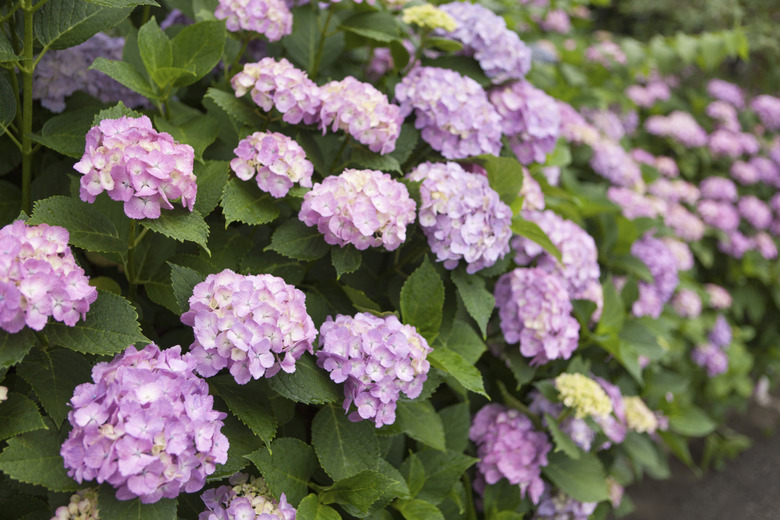Why Do The Edges Of My Hydrangea Leaves Turn Brown?
With their broad leaves and clusters of long-lasting fall and summer-blooming flowers, hydrangea (Hydrangea spp.) is an attractive deciduous shrub that comes with the added bonus of being shade tolerant and low maintenance. A hydrangea with brown leaf margins is likely suffering from a cultural problem, disease or pest infestation.
Fertilizer Facts
Excessive fertilizer or pesticide use can cause toxicity symptoms in hydrangeas, causing symptoms such as browning or burning on the leaf margins, leaf tip dieback and increased susceptibility to pests. Herbicide drift can also affect the shrub. Bigleaf hydrangea (Hydrangea macrophylla) does best with light applications of fertilizer. The United States National Arboretum recommends applying 2 cups of a balanced fertilizer, such as a 10-10-10 fertilizer, per 100 square feet in March, May and July. Water after fertilizing to help disperse the chemicals into the soil.
Transplanting Troubles
Newly transplanted hydrangeas may be struggling with a lack of moisture, as potted nursery plants often come potted in a soil mixture high in peat moss, which dries out quickly. The University of Illinois Extension recommends digging up recently planted nursery starters and checking the roots. If roots are compactly woven together, carefully loosen with your hand and soak the root ball in water. Replant and water frequently to keep the soil uniformly moist. Hydrangeas in general prefer moist soil, benefiting from weekly irrigation.
Fungal Funk
Numerous species of fungus may attack hydrangea leaves, causing unattractive brown spots. Prevent fungal disease by keeping water off the leaves whenever you irrigate. Although some afternoon sunlight promotes blooms, too much sunlight, when coupled with wet leaves, can cause fungal spots. Hydrangeas generally prefer dappled shade. Prune off and destroy damaged or diseased leaves, and clear up any dropped flowers and plant debris from under the shrub. Disinfect pruners with household disinfectant before use and between pruning each shrub to avoid spreading disease. Provide at least 6 feet of space between shrubs to allow for ample air circulation.
Other Potential Problems
Support your hydrangea by providing it with the proper cultural conditions. Only plant hydrangeas where hardy: bigleaf hydrangea, the most widely cultivated species, is hardy in U. S. Department of Agriculture plant hardiness zones 6 to 10. Most hydrangeas prefer well-draining, rich soil. Check occasionally for pests such as aphids and scale insects, which can cause leaves to shrivel and turn brown. Wash off pests with a direct stream of water. Avoid the use of broad-spectrum insecticides, which kill beneficial predatory insects and can scorch leaves if overused.
References
- Northeast Nursery: Hydrangeas: Color + Fertilizing
- Clemson Cooperative Extension: Hydrangea
- University of California Davis Integrated Pest Management Program: Hydrangea
- Houston Chronicle: What Are the Brown Spots on My Hydrangeas?
- University of Illinois Extension: Hydrangea Leaves Turning Brown on Edges
- The United States National Arboretum: Hydrangea Questions and Answers
- University of California Davis Integrated Pest Management Program: Nutrient and Mineral Excesses
- Floridata: Hydrangea Macrophylla
